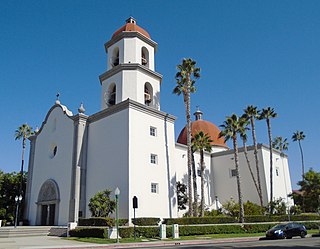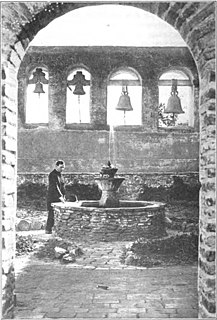
Mission San Juan Capistrano is a Spanish mission in San Juan Capistrano, Orange County, California. Founded in 1776 in colonial Las Californias by Spanish Catholic missionaries of the Franciscan Order, it was named for Saint John of Capistrano. The Spanish Colonial Baroque style church was located in the Alta California province of the Viceroyalty of New Spain. The Mission was secularized by the Mexican government in 1833, and returned to the Roman Catholic Church by the American government in 1865. The mission was damaged over the years by a number of natural disasters, but restoration and renovation efforts date from around 1910.

Abruzzo or Abruzzi is a region of Southern Italy with an area of 10,763 square km and a population of 1.3 million. It is divided into four provinces: L'Aquila, Teramo, Pescara, and Chieti. Its western border lies 80 km (50 mi) east of Rome. Abruzzo borders the region of Marche to the north, Lazio to the west and south-west, Molise to the south-east, and the Adriatic Sea to the east. Geographically, Abruzzo is divided into a mountainous area in the west, which includes the Gran Sasso d'Italia, and a coastal area in the east with beaches on the Adriatic Sea.

San Juan Capistrano is a city in Orange County, California, United States. The current Office of Management and Budget metropolitan designation for San Juan Capistrano and the Orange County area is Santa Ana–Anaheim–Irvine, CA. The population was 34,593 at the 2010 census, up from 33,826 at the 2000 census.

Saint John of Capistrano was a Franciscan friar and Catholic priest from the Italian town of Capestrano, Abruzzo. Famous as a preacher, theologian, and inquisitor, he earned himself the nickname 'the Soldier Saint' when in 1456 at age 70 he led a crusade against the invading Ottoman Empire at the siege of Belgrade with the Hungarian military commander John Hunyadi.

Mission Basilica San Juan Capistrano is a Catholic parish in the Diocese of Orange in California. The parish church is located just northwest of Mission San Juan Capistrano in the city of San Juan Capistrano, California, United States. Completed in 1986, it was designated a minor basilica in 2000 and a national shrine in 2003.
The Santa Ana Valley is located in Orange County, California and is bisected by the Santa Ana River. The valley is home to most of Orange County's central business districts. The cities of Anaheim, Buena Park, Costa Mesa, Fullerton, Irvine, Orange, Placentia, Santa Ana, and Yorba Linda are located in the Santa Ana Valley.
Capistrano Unified School District (CUSD) is the second largest school district in Orange County, California, United States. It is the 8th largest district in the state and the 78th largest in the country. The district currently has 54,036 students and administers 33 elementary schools, two K-8 schools, ten middle schools, six comprehensive high schools, five charter schools, and multiple alternative education programs.

San Antonio Missions National Historical Park is a National Historical Park and part of a UNESCO World Heritage Site preserving four of the five Spanish frontier missions in San Antonio, Texas, USA. These outposts were established by Catholic religious orders to spread Christianity among the local natives. These missions formed part of a colonization system that stretched across the Spanish Southwest in the 17th, 18th, and 19th centuries.

Mission San Juan Capistrano was founded in 1731 by Spanish Catholics of the Franciscan Order, on the eastern banks of the San Antonio River in present-day San Antonio, Texas. The new settlement was named for a 15th-century theologian and warrior priest who resided in the Abruzzo region of Italy. The mission San Juan was named after Saint John of Capestrano.

Capestrano is a comune and small town with 885 inhabitants (2017), in the Province of L'Aquila, Abruzzo, Italy. It is located in the Gran Sasso e Monti della Laga National Park.

The Acjachemen are an indigenous people of California. They traditionally lived south of what is known as the Aliso creek and what was originally known as San Diego County [], San Diego counties. Acjachemen were referred to as Juaneño by Spanish colonizers following baptism at Mission San Juan Capistrano in the late eighteenth century. Today many contemporary members of the tribe who identify as descendants of the indigenous society living in the local San Juan and San Mateo Creek drainage areas prefer the term Acjachemen as their autonym, or name for themselves, in an effort to decolonize their history.
The Sea View League, along with the South Coast League in Orange County, California, make up the ten member high schools of the Coast View Conference, which is part of the California Interscholastic Federation's Southern Section.

The Diego Sepúlveda Adobe is an adobe structure in Costa Mesa, Orange County, California.

The Right Reverend St. John O'Sullivan was a Catholic priest who personally undertook the restoration of the old Mission San Juan Capistrano in California.

Song of the Swallows is a book by Leo Politi. Published by Scribner, it was the recipient of the Caldecott Medal for illustration in 1950.

San Juan Capistrano station is a train station in San Juan Capistrano, California, United States served by Amtrak, the national railroad passenger system, and Metrolink, a commuter railroad. The station has a single side platform serving the single track of the Orange Subdivision.

San Juan Creek, also called the San Juan River, is a 29-mile (47 km) long stream in Orange County, California, draining a watershed of 133.9 square miles (347 km2). Its mainstem begins in the southern Santa Ana Mountains in the Cleveland National Forest. It winds west and south through San Juan Canyon, and is joined by Arroyo Trabuco as it passes through San Juan Capistrano. It flows into the Pacific Ocean at Doheny State Beach. San Juan Canyon provides a major part of the route for California State Route 74.
The California mission clash of cultures occurred at the Spanish Missions in California during the Spanish Las Californias-New Spain and Mexican Alta California eras of control, with lasting consequences after American statehood. The Missions were religious outposts established by Spanish Catholic Franciscans from 1769 to 1823 for the purpose of protecting Spain's territory by settlements and converting the Californian Native Americans to a Christian religion.

The 1812 San Juan Capistrano earthquake, also known as the Wrightwood earthquake, occurred on December 8 at in Alta California. At the time, this was a colonial territory of the Spanish Empire. Damage occurred at several of the missions in the region of Pueblo de Los Ángeles, including Mission San Gabriel Arcángel and Mission San Juan Capistrano, where 40 parishioners were killed during the collapse of a church at an early morning service. Tree ring and paleoseismic evidence show that there is a strong likelihood that the earthquake originated along the Mojave segment of the San Andreas Fault near Wrightwood, but other faults have been suggested as the cause.

The Los Rios Historic District is an historic district and neighborhood in the city of San Juan Capistrano, California. With buildings dating to 1794, it is the oldest continually occupied neighborhood in the state. The nearby Mission San Juan Capistrano was the first of the 21 California Missions to have Indians, soldiers and workers live outside the mission grounds. Three adobes are remaining in the Los Rios neighborhood itself, although there are a number of others close by which were part of what was once a larger neighborhood.















